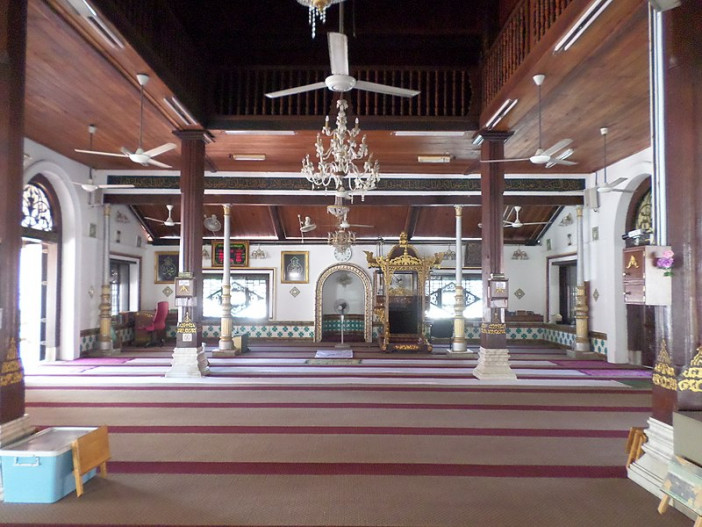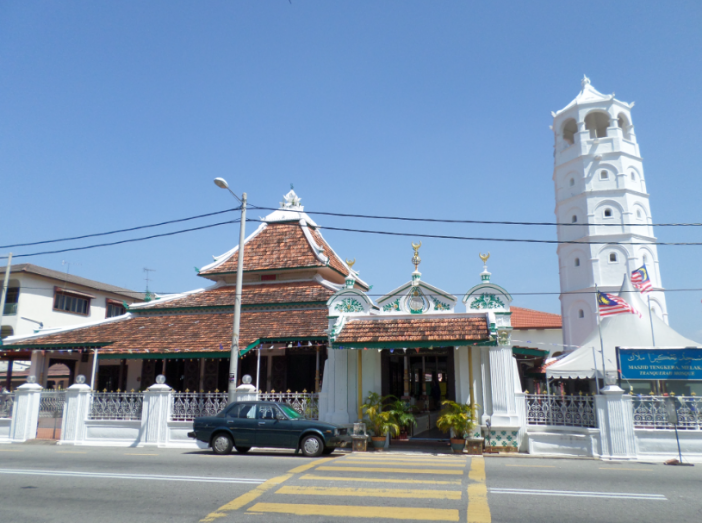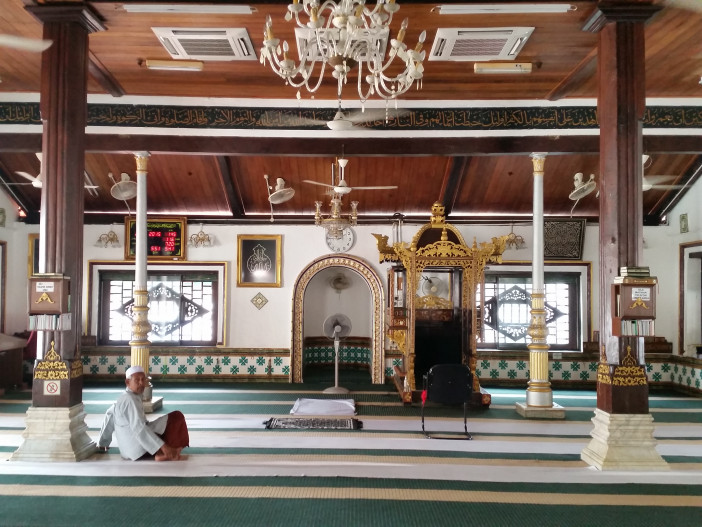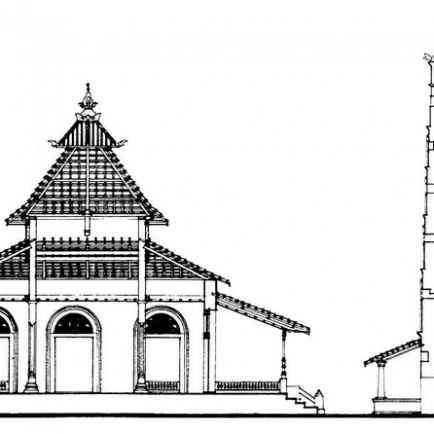Tengkera Mosque
History
The mosque was built in 1728 by a merchant and scholar from India, Muhammad Salleh and is a historic mosque because it was built during the Dutch rule. This mosque was renovated twice in 1890 and 1910
Urban and Architectural
The main part of the mosque, which is emphasised in the construction of this mosque, is the roof. The structure of the roof is made of hardwood. The lowest level of the roof is called cucur atap, and its function is to shade the veranda. The middle part of the roof acts as a connector between the upper and lower levels. At the highest level, which is known as the peak of the roof, there are beautiful carvings and filigree. This peak is believed to be carved out of corals stone. The construction of the roof with clay roof tiles brought by Muslim traders from Italy was based on a rectangular roof plan. Columns are erected at the four corners, and a central column is placed there to support the load of this pyramidal roof.
Another important trait in the mosque is the mihrab. By the side of the mihrab is the minbar where the imam delivers the sermon. Masjid Tengkera has a minbar made of intan wood that is beautifully carved. Female worshippers are separated from the male worshippers with the curtains that can be adjusted.
The main prayer hall that is covered with carpet is also equipped by a veranda that can be used if the main prayer hall is full and also acts as an intermediate space between the indoor and outdoor spaces. The prayer hall and veranda are elevated above the ground and the staircase is built so as to maintain cleanliness and differentiate the usage of the space.
Masjid Tengkera has a six-storeyed minaret. The space at the top of the minaret is fitted with loudspeakers where a taboh was placed and used in the past. This taboh that looks like a drum is still being kept and, in the past, was knocked with various different rhythm to inform the people about things such as prayer time, emergency and death. There are stairs to get to the top level. The minaret was built separately from the mosque but connected with a covered walkway. The whole area of the mosque is fenced by a brick wall of 1.3 metres (four feet) high to separate the surroundings. In the southern part of the mosque, the compound is a cemetery, to the west is the road leading to Melaka City, while the north and east sides are surrounded by the village. This mosque is also equipped with an ablution pond
Description
Tengkera Mosque is a mosque located in Tengkera in the Melaka Tengah district, Melaka, Malaysia . The name Tengkera comes from the Portuguese word tranquerah which means fortress. This mosque is also the second oldest mosque in Malaysia after Kampung Hulu Mosque in Malacca.
References
https://itc.gov.my/listings/masjid-tengkera-bandaraya-melaka/
https://ms.wikipedia.org/wiki/Masjid_Tengkera
Details
الموقع
Jalan Tengkera, 75200 Melaka, Malaysia
عدد المصليين
200
المالك / المتبرع
Muhammad Salleh
المعماري
تاريخ البناء
1728
Area
534
الرسومات المعمارية
الخريطة
History
The mosque was built in 1728 by a merchant and scholar from India, Muhammad Salleh and is a historic mosque because it was built during the Dutch rule. This mosque was renovated twice in 1890 and 1910
Urban and Architectural
The main part of the mosque, which is emphasised in the construction of this mosque, is the roof. The structure of the roof is made of hardwood. The lowest level of the roof is called cucur atap, and its function is to shade the veranda. The middle part of the roof acts as a connector between the upper and lower levels. At the highest level, which is known as the peak of the roof, there are beautiful carvings and filigree. This peak is believed to be carved out of corals stone. The construction of the roof with clay roof tiles brought by Muslim traders from Italy was based on a rectangular roof plan. Columns are erected at the four corners, and a central column is placed there to support the load of this pyramidal roof.
Another important trait in the mosque is the mihrab. By the side of the mihrab is the minbar where the imam delivers the sermon. Masjid Tengkera has a minbar made of intan wood that is beautifully carved. Female worshippers are separated from the male worshippers with the curtains that can be adjusted.
The main prayer hall that is covered with carpet is also equipped by a veranda that can be used if the main prayer hall is full and also acts as an intermediate space between the indoor and outdoor spaces. The prayer hall and veranda are elevated above the ground and the staircase is built so as to maintain cleanliness and differentiate the usage of the space.
Masjid Tengkera has a six-storeyed minaret. The space at the top of the minaret is fitted with loudspeakers where a taboh was placed and used in the past. This taboh that looks like a drum is still being kept and, in the past, was knocked with various different rhythm to inform the people about things such as prayer time, emergency and death. There are stairs to get to the top level. The minaret was built separately from the mosque but connected with a covered walkway. The whole area of the mosque is fenced by a brick wall of 1.3 metres (four feet) high to separate the surroundings. In the southern part of the mosque, the compound is a cemetery, to the west is the road leading to Melaka City, while the north and east sides are surrounded by the village. This mosque is also equipped with an ablution pond
Description
Tengkera Mosque is a mosque located in Tengkera in the Melaka Tengah district, Melaka, Malaysia . The name Tengkera comes from the Portuguese word tranquerah which means fortress. This mosque is also the second oldest mosque in Malaysia after Kampung Hulu Mosque in Malacca.








